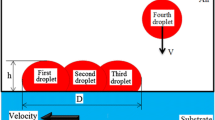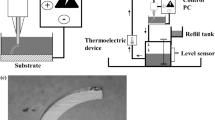Abstract
Metal micro-droplet 3D printing is an effective additive manufacturing technique to form micro pillar structures. However, the control mechanism of the pillar contour is still unclear. To form a pillar with uniform radius, it is essential to investigate the dependence of processing parameters on pillar contours. In this study, a 3D numerical model was employed to simulate and analyze the successive pileup processes of multiple droplets. The solidification angle of solidified new-coming droplets is defined to characterize the pillar contour. An analytic equation of solidification angle was established. In this case, the solidified morphology of the droplets could be feasibly predicted through thermophysical parameters and initial conditions. This work provides good physical understanding of the complicated mechanisms for fabricating a pillar structure by means of the successive pileup of molten metal droplets, and paves the way for pillar contour control.
Similar content being viewed by others
Abbreviations
- ρ :
-
Metal material density
- U :
-
Velocity vector
- P :
-
Pressure vector
- τ :
-
Shear stress vector
- S :
-
Temperature-dependent source term
- F vol :
-
Surface tension vector of the free surface
- σ :
-
Surface tension
- κ :
-
Curvature ratio of the interface
- n :
-
Unit normal vector
- ρ g :
-
Density of the gas
- \(\overline \rho \) :
-
Average density of a cell to the free surface
- Ω+ :
-
The region of molten material
- Ω− :
-
Void region
- Γ:
-
Common boundary between Ω+ and Ω−
- f s :
-
The solid fraction of fluid
- v 0 :
-
Droplet impact velocity
- C :
-
Specific heat
- ΔT :
-
Temperature gradient between droplet and substrate
- k :
-
Thermal conductivity
- μ :
-
Viscosity
- H :
-
Enthalpy
- H ref :
-
Explicit enthalpy of the reference temperature
- T ref :
-
Reference temperature
- L :
-
Latent heat of fusion
- R c :
-
Contact thermal resistance
- R h :
-
Arithmetical average height
- T sub,0 :
-
Initial temperature of substrate
- T 0 :
-
Initial temperature of droplet
- We :
-
Weber number
- Re :
-
Reynolds number
- θ :
-
Solidification angle
- Q :
-
Heat flux
- A c :
-
Average cross-section area of the interface
- R h :
-
Thermal resistance of the pillar
- h :
-
Current height of the pillar
- R c :
-
Contact thermal resistance
- ξ :
-
Correction factor
- t s :
-
Total solidification time
- Tpre :
-
Temperature of the previous solidified droplet
- λ :
-
A parameter relating the initial condition
- Δh :
-
Increment of pillar height
- r b :
-
Radius of contact line
- r c :
-
Radius of solidified droplet (the number in subscript is droplet index)
- r col :
-
Diameter of pillar contour
- sub:
-
A subscript that indicates a parameter related to the substrate
References
W. M. Farnworth, Micro-pillar Fabrication Utilizing a Stereolithographic Printing Process, U.S. Patent 5484314 (1996).
Y. Zhang, C.-T. Lin and S. Yang, Fabrication of hierarchical pillar arrays from thermoplastic and photosensitive SU-8, Small, 6(6) (2010) 768–775.
J. Lee et al., A numerical study on the dynamic behavior of the liquid located between pillar-shaped structures, J. Mech. Sci. Technol, 28(10) (2014) 4221–4232.
W. Koh, B. Lin and J. Tai, Copper pillar bump technology progress overview, 12th Int. Conf. Electron. Packag. Technol. High Density Packag., IEEE, Shanghai, China (2011) 1–5.
L. Qi et al., Quantitative characterization and influence of parameters on surface topography in metal micro-droplet deposition manufacture, Int. J. Mach. Tools Manuf., 88 (2015) 206–213.
Y. Chao et al., Remelting and bonding of deposited aluminum alloy droplets under different droplet and substrate temperatures in metal droplet deposition manufacture, Int. J. Mach. Tools Manuf., 69 (2013) 38–47.
J. Luo et al., Printing functional 3D microdevices by laser-induced forward transfer, Small, 13(9) (2017) 1602553.
C. W. Visser et al., Toward 3D printing of pure metals by laser-induced forward transfer, Adv. Mater., 27(27) (2015) 4087–4092.
F. Gao and A. A. Sonin, Precise deposition of molten micro-drops: The physics of digital microfabrication, Proc. Math. Phys. Sci., 444(1922) (1994) 533–554.
S. Haferl and D. Poulikakos, Transport and solidification phenomena in molten microdroplet pileup, J. Appl. Phys., 92(3) (2002) 15.
J. Che, S. L. Ceccio and G. Tryggvason, Computations of structures formed by the solidification of impinging molten metal drops, Appl. Math. Model., 28(1) (2004) 127–144.
M. Fang, S. Chandra and C. B. Park, Experiments on remelting and solidification of molten metal droplets deposited in vertical columns, J. Manuf. Sci. Eng., 129(2) (2007) 311.
M. Fang, S. Chandra and C. B. Park, Building three-dimensional objects by deposition of molten metal droplets, Rapid Prototyp. J., 14(1) (2008) 44–52.
K. Rahman et al., Simulation of droplet generation through electrostatic forces, Journal of Mechanical Science and Technology, 24(1) (2010) 307–310.
J. U. Brackbill, D. B. Kothe and C. Zemach, A continuum method for modeling surface tension, J. Comput. Phys., 100(2) (1992) 335–354.
C. W. Hirt and B. D. Nichols, Volume of fluid (VOF) method for the dynamics of free boundaries, J. Comput. Phys., 39(1) (1981) 201–225.
H. Li et al., Simulation on deposition and solidification processes of 7075 Al alloy droplets in 3D printing technology, Trans. Nonferrous Met. Soc. China, 24(6) (2014) 1836–1843.
M. Pasandideh-Fard, S. Chandra and J. Mostaghimi, A three-dimensional model of droplet impact and solidification, Int. J. Heat Mass Transf., 45(11) (2002) 2229–2242.
S. D. Aziz and S. Chandra, Impact, recoil and splashing of molten metal droplets, Int. J. Heat Mass Transf., 43(16) (2000) 2841–2857.
M. Pasandideh-Fard et al., Deposition of tin droplets on a steel plate: Simulations and experiments, Int. J. Heat Mass Transf., 41(19) (1998) 2929–2945.
R. Dhiman and S. Chandra, Freezing-induced splashing during impact of molten metal droplets with high Weber numbers, Int. J. Heat Mass Transf., 48(25–26) (2005) 5625–5638.
T. Loulou, E. A. Artyukhin and J. P. Bardon, Estimation of thermal contract resistance during the first stages of metal solidification process: II. Experimental setup and results, Int. J. Heat Mass Transf., 42(12) (1999) 2129–2142.
C. Yanpu, Q. Lehua and B. Zhengmin, 3D dynamic simulation analysis of thermal-mechanical coupling during 7075 aluminum alloy micro-droplet deposition manufacture, Rare Met. Mater. Eng., 45(8) (2016) 1924–1930.
J. Du and Z. Wei, Numerical analysis of pileup process in metal microdroplet deposition manufacture, Int. J. Therm. Sci., 96 (2015) 35–44.
H. Li, 3D numerical simulation of successive deposition of uniform molten Al droplets on a moving substrate and experimental validation, Comput. Mater. Sci., 65 (2012) 291–301.
M. Pasandideh-Fard et al., Capillary effects during droplet impact on a solid surface, Phys. Fluids, 8(3) (1996) 650–659.
D. Attinger, Z. Zhao and D. Poulikakos, An experimental study of molten microdroplet surface deposition and solidification: Transient behavior and wetting angle dynamics, J. Heat Transf., 122(3) (2000) 544–556.
S. Schiaffino and A. A. Sonin, Molten droplet deposition and solidification at low Weber numbers, Phys. Fluids, 9(11) (1997) 3172–3187.
S. Schiaffino and A. A. Sonin, Motion and arrest of a molten contact line on a cold surface: An experimental study, Phys. Fluids, 9(8) (1997) 2217–2226.
S. Schiaffino and A. A. Sonin, On the theory for the arrest of an advancing molten contact line on a cold solid of the same material, Phys. Fluids, 9(8) (1997) 2227–2233.
L. J. Zarzalejo, K. S. Schmaltz and C. H. Amon, Molten droplet solidification and substrate remelting in microcasting, Part I: numerical modeling and experimental verification, Heat Mass Transf., 34(6) (1999) 477–485.
S. Haferl and D. Poulikakos, Experimental investigation of the transient impact fluid dynamics and solidification of a molten microdroplet pile-up, Int. J. Heat Mass Transf., 46(3) (2003) 535–550.
H. Yi et al., Effect of the surface morphology of solidified droplet on remelting between neighboring aluminum droplets, Int. J. Mach. Tools Manuf., 130–131 (2018) 1–11.
W. Xiong et al., Experimental investigation on the height deviation of bumps printed by solder jet technology, J. Mater. Process. Technol., 243 (2017) 291–298.
C. H. Amon et al., Numerical and experimental investigation of interface bonding via substrate remelting of an impinging molten metal droplet, J. Heat Transf., 118(1) (1996) 164.
Acknowledgments
This work was supported by the National Natural Foundation of China (No. 51475266, 51005134).
Author information
Authors and Affiliations
Corresponding authors
Additional information
Recommended by Editor Chongdu Cho
Congping Chen is a Professor of Mechanical Engineering at Changzhou University. Professor Chen received his Ph.D. in 2007 from Huazhong University of Science and Technology. His research interests include 3D printing and intelligent manufacturing.
Jiequang Huang is a Ph.D. student at School of Mechanical Engineering, Northwestern Polytechnical University. His main research interests focus on droplet-based 3D printing, droplet ejection, and droplet impingement, etc.
Hao Yi is an Assistant Professor in the College of Mechanical Engineering at Chongqing University, China. He is serving as an Associate Editor for Micro & Nano Letters, The Journal of Engineering, an editorial board member for Production Engineering, Fluid Dynamics & Materials Processing, Heliyon, and a peer reviewer for nearly 50 SCI-indexed journals. His main research interests focus on 3D printing and additive manufacturing, spray forming, green manufacturing, production research, etc.
Yi Zhang is a Professor of Mechanical Engineering at Changzhou University. Professor Zhang received his Ph.D. in 2005 from University of Science and Technology of China. His research interests include CAM/CAPP/CAE/CIMS.
Rights and permissions
About this article
Cite this article
Chen, C., Huang, J., Yi, H. et al. Research on the solidified morphologies of successive pileup metal droplets. J Mech Sci Technol 34, 3197–3205 (2020). https://doi.org/10.1007/s12206-020-0711-5
Received:
Revised:
Accepted:
Published:
Issue Date:
DOI: https://doi.org/10.1007/s12206-020-0711-5




